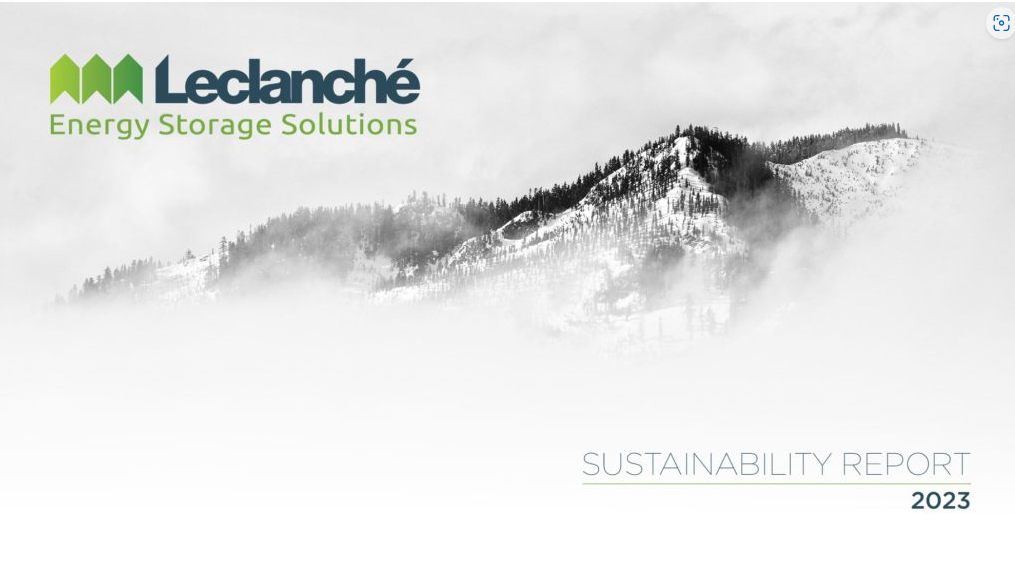Company News
Leclanché Releases its First Sustainability Report for 2023

Why a Sustainability Report?
Since Leclanché’s objective is to reduce carbon emissions in heavy mobility, sustainability is at the core of our business. The report serves as a tool to showcase this commitment and our strategy to investors, customers, and certifications such as ECOVADIS, highlighting how we align with climate change risks, market dynamics, and regulations.
What is in the Report?
A sustainability report is an opportunity to promote our activities. The first chapter presents the market perspectives and our unique positioning.
Then, we focus on the European regulation promoting our battery manufacturing activity to decarbonise mobility and energy production.
Further on, we include three standard chapters covering ESG: Environment, Social and Governance.
Why is the regulation important for Leclanché?
The European Green Deal is an ambitious plan to make the European Union carbon-neutral by 2050 through a wide range of initiatives. The battery sector is at the heart of this plan, which you can see on page 17.
On the left part of the illustration, we see all the rules put in place to finance the Green Deal:
- The SFDR (Sustainable Finance Disclosure Regulation) is a regulation designed to classify investment funds based on the sustainability of the companies’ activities within the funds. Leclanché worked in 2023 to provide indicators showing that our activity is sustainable so that we can join the best-in-class type of fund, called an “Article 9” fund.
- The EU taxonomy is a classification method to establish common rules for evaluating whether an activity is sustainable or not, to avoid greenwashing and false claims. Battery production for mobility and energy production is considered a sustainable activity according to the EU taxonomy.
- The CSRD (Corporate Sustainability Reporting Directive) is a new directive to improve transparency and sustainability reporting requirements for companies operating within the European Union. Leclanché started to follow the principle of writing this report.
The EU regulation on batteries is a major milestone for Europe, as batteries are used as a pilot project to integrate all principles to increase sustainability by setting up a circular economy for batteries: from traceability of the supply chain to mandatory carbon footprint, recycling obligations with a recovery rate of up to 95%…
Last but not least, Europe wants to ban dangerous chemicals such as PFAS via the “Chemical Strategy for Sustainability” (on the right part of the illustration). Leclanché is one of the world’s first to shift to PFAS-free cell production, as we can see on pages 21 to 23.
What does ‘Governance’ mean?
In ESG, governance refers to how Leclanché incorporates sustainability into its organisation, operations, business model, and conducts risk and opportunity analysis, while in the chapter on Governance, we outline existing initiatives for responsible mining and efforts to prevent child labour.
What are the long-term scenarios presented at the beginning of the ‘environment’ chapter?
The CSRD requests are used to evaluate different climate scenarios. We have evaluated 2 scenarios:
In the best-case scenario, there’s a risk of rapid transition, presenting a significant opportunity for Leclanché’s business as accelerated decarbonisation is necessary to stay below 1.5-2°C.
However, in the second scenario, a pessimistic outlook with reduced decarbonisation objectives may lead to increased climate events like the recent flooding in Germany, posing catastrophic risks to our operations. The CSRD mandates us to assess such risks and their financial implications.
What are the differences between ‘company carbon footprint’, ‘avoided emissions’ and ‘battery carbon footprint’?
Company Carbon Footprint
This refers to the total amount of greenhouse gas emissions (usually measured in CO2 equivalents) produced directly and indirectly by a company’s operations, including its supply chain, energy usage, transportation, and waste disposal. It measures the environmental impact of the company’s activities. Its calculation is requested by the investors.
Avoided Emissions
These are emissions that are prevented as a result of using our batteries in trains or ships instead of diesel engines. This is a great achievement because few companies have a positive impact through their activity like Leclanché.
Battery Carbon Footprint
This specifically relates to the carbon emissions generated throughout the entire lifecycle of the battery: raw material extraction, manufacturing, transportation, usage, and disposal/recycling. We closely follow the methodology currently being defined at the EU level to compare with our competition. We reduced it by 35 % thanks to the usage of renewable electricity and the Water-based process used in our cell factory.
What is Leclanché doing to reduce its environmental impact?
Several initiatives are in place to reduce the environmental impact of our batteries at each step of the lifecycle:
- Manufacturing (page 46): We utilise renewable electricity in both our German and Swiss factories and employ a unique water-based process that eliminates toxic solvents, improving the health and safety of our operators.
- Usage (page 47): We extend the lifetime of our batteries through a high number of cycles compared to our competitors. While our customers may need to replace batteries multiple times over the lifespan of a train or ship (20-30 years), our batteries require fewer replacements to maintain the same level of performance.
- End of life (page 49): We have established a recycling process and partnerships with recyclers as part of the 6R concept of the circular economy.
What does Leclanché do for the social part?
In the report, we highlighted recruitment, the onboarding process, the home office policy, the sustainability academy, and moreover, the Health and Safety measures put in place.
Why so many annexes?
We aimed to align the reporting requirements of the CSRD with the content presented in this report.
The report is available here: https://www.leclanche.com/wp-content/uploads/2023/10/Leclanche-Sustainability-Report-2023.pdf